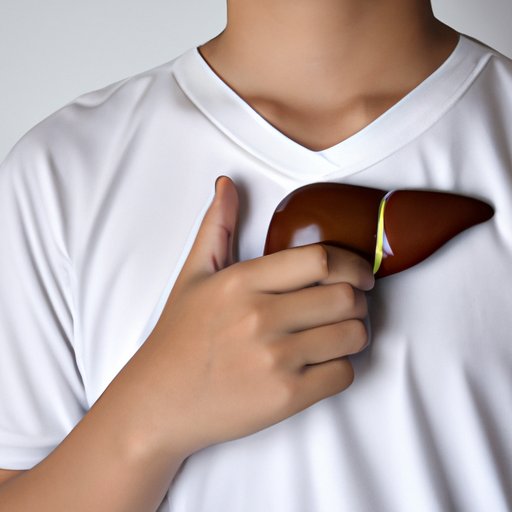
Introduction
Liver disease affects millions of people around the world and can have serious health consequences if left untreated. One symptom or complication of liver disease that is often overlooked is pruritus or itching. Understanding the relationship between pruritus and liver disease is crucial for proper diagnosis and treatment. In this article, we will explore the different stages of liver disease and how itching can indicate advanced liver complications. We will also discuss possible treatment options and how to recognize and manage pruritus in patients with liver disease.
The Itch that Indicates a Problem: Understanding Liver Disease and its Symptoms
The liver is a vital organ that plays many important roles in the body, such as filtering toxins from the blood, producing bile to aid in digestion, and regulating blood sugar levels. When the liver is damaged or diseased, it cannot perform these functions effectively, which can lead to a range of complications.
Common signs and symptoms of liver disease include fatigue, weakness, jaundice, abdominal pain, and itching. The itch is often the first symptom that indicates the presence of liver disease. It typically occurs on the palms of the hands and soles of the feet, but can also affect other parts of the body.
Why Liver Disease Makes You Itch: The Relationship Between Pruritus and Liver Health
Pruritus, or itching, is a common symptom of liver disease that is caused by the build-up of bile acids in the bloodstream. Bile is a yellow-green fluid that is produced by the liver and stored in the gallbladder. It helps to break down fats in the small intestine and aids in the absorption of fat-soluble vitamins.
In liver disease, the liver is unable to process bile acids effectively, which leads to their accumulation in the bloodstream. These excess bile acids can then bind to receptors in the skin, causing itching and other dermatologic symptoms.
Exploring the Stages of Liver Disease: How Itching can Indicate Advanced Liver Complications
Liver disease progresses through several stages, ranging from mild inflammation to severe liver damage and cirrhosis. When itching occurs in the early stages of liver disease, it is usually mild and does not require treatment. However, as liver disease progresses and complications develop, itching can become more severe and difficult to manage.
Advanced liver disease can cause a range of complications, including ascites (fluid buildup in the abdomen), hepatic encephalopathy (brain dysfunction), and liver cancer. Severe itching can be a sign of these complications and may require more aggressive treatment.
The treatment options for advanced liver disease vary depending on the specific complication. Some treatments may include medications to reduce the accumulation of bile acids, diuretics to reduce fluid buildup, and other supportive therapies.
The Unbearable Itch: Recognizing and Managing Pruritus in Patients with Liver Disease
Diagnosing pruritus in liver disease patients can be challenging, as it can be caused by a range of factors, including medications, infections, and other medical conditions. Patients who develop itching should be evaluated by a healthcare professional to determine the underlying cause.
Non-pharmacologic treatment options for pruritus include lifestyle changes, such as avoiding hot showers and using unscented soap, and home remedies, such as applying cool compresses to the affected areas and using oatmeal baths. These treatments can help to reduce the severity of itching and improve quality of life.
Pharmacologic treatment options for pruritus include antihistamines, such as hydroxyzine and diphenhydramine, and bile acid sequestrants, such as cholestyramine and colesevelam. These medications can help to reduce the accumulation of bile acids in the bloodstream and reduce itching.
Itching for Answers: Understanding the Cause and Treatment of Pruritus in Liver Disease
The cause of pruritus in liver disease patients is not fully understood, but it is thought to be related to liver injury and dysfunction. New and emerging treatments for pruritus include the use of opioid antagonists, such as naltrexone and naloxone, and the use of topical agents, such as capsaicin and menthol.
Patients with pruritus should work closely with their healthcare provider to determine the best treatment plan for their individual needs. Treatment may involve a combination of non-pharmacologic and pharmacologic therapies, as well as ongoing monitoring and evaluation.
The Tell-Tale Sign of Liver Disease: How Itching can Help Diagnose and Monitor Liver Health
Itching can be a helpful indicator of liver disease and liver health, as it is often the first symptom that presents in patients with liver disease. Regular monitoring and evaluation of itching and other symptoms can help to diagnose liver disease in its early stages and prevent complications.
Patients with liver disease should work closely with their healthcare provider to develop a comprehensive treatment plan that addresses their individual needs and goals. This may include lifestyle changes, such as maintaining a healthy diet and exercise program, and regular monitoring and evaluation of liver function.
Conclusion
Pruritus is a common symptom of liver disease that can have a significant impact on quality of life. Understanding the relationship between pruritus and liver disease is essential for proper diagnosis and treatment. Patients with liver disease should work closely with their healthcare provider to manage pruritus and other symptoms and prevent complications.
If you are experiencing unexplained itching or other symptoms of liver disease, it is essential to seek medical attention promptly. Early diagnosis and treatment can help to prevent complications and improve overall health and well-being.




